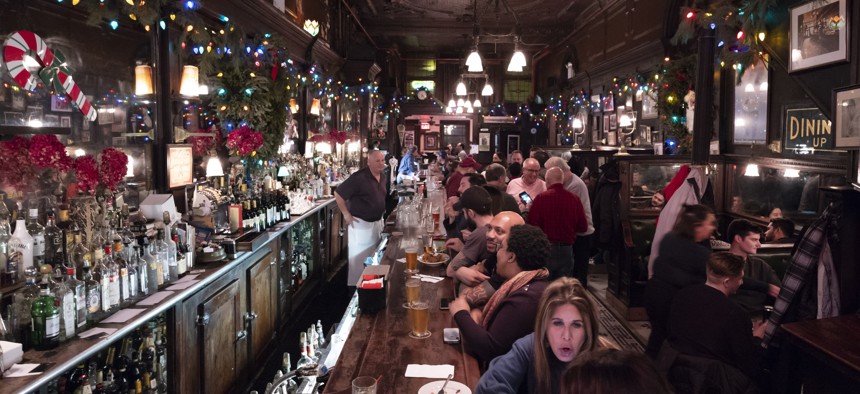State Can’t Ban Ads for Discount Booze, Appeals Court Rules

In this Dec. 27, 2019 photo, customers mingle in New York's Old Town Bar. Once a speakeasy during Prohibition, the Old Town Bar opened in 1892. AP Photo/Mark Lennihan

Connecting state and local government leaders
The 8th U.S. Circuit Court of Appeals found Missouri restrictions on alcohol advertising violated the First Amendment.
A federal appeals court ruled against limits on alcohol advertisements in Missouri that prevented bars and restaurants from mentioning deals like penny pitchers or two-for-one beer specials.
The restrictions violated the free speech rights of liquor distributors, manufacturers and retailers, the 8th U.S. Circuit Court of Appeals found, upholding a lower court ruling.
Numerous laws challenging the regulation of so-called vice advertising, typically peddling alcohol, tobacco or gambling, have not fared well against First Amendment challenges, said Anastasia Boden, a senior attorney with the libertarian Pacific Legal Foundation.
“Those regulations are almost always struck down but there is no clear reason why,” she said, acknowledging that courts have relied on differing rational.
At issue in the Missouri case were three regulations restricting alcohol advertising under the state’s "three-tiered system," which separates manufacturers, distributors and retailers. The Missouri Broadcasters Association, as well as a bar and winemaker in the state, challenged the rules.
The regulations prohibit retailers from advertising either discounted prices or prices below their actual cost outside of their establishment. Further, manufacturers and distributors were banned from retail advertising. As the 8th Circuit described the conundrum: “Joe’s Bar could run the ad, ‘Drink Coors Light, now available at Joe’s Bar,’ but a producer or distributor could not.”
“Although the Statute on its face does not restrict speech, its practical operation restricts speech based on content and speaker identity,” wrote U.S. Circuit Judge Jane Kelly for the 8th Circuit panel. “
The 8th Circuit decision, issued earlier this month, is the latest case to chip away at states’ justifications that it is in the public interest to restrict alcohol advertising in order to reduce excessive or underage drinking.
The Supreme Court ruled in 1996 that states could not prohibit the advertising of alcohol prices, setting the stage for future challenges. Virginia’s liquor laws were changed in 2019 to allow happy hour advertisements after a restaurant owner sued.
In the Missouri case, the 8th Circuit said the state offered no expert opinion or empirical or statistical evidence supporting its contention that the regulations were needed to prevent overconsumption of alcohol or underage drinking.
The ruling demonstrates the difficulty states may have in justifying and defending Prohibition-era laws that regulate the alcohol industry, said Cory Andrews, vice president of litigation with the Washington Legal Foundation, which filed a brief supporting the plaintiffs in the case.
“If the courts want to hold the states feet to the fire and make them prove their case, as the 8th Circuit did, they may not be able to do so,” Andrews said. “The Supreme Court and federal courts in general have gradually come around to the view that if the speech in question is truthful and non-misleading, you have to meet a high bar to prohibit it.”
The ruling sets up a split with the 9th Circuit, which, while it did not curtail pricing-related advertising, did give states more leeway to restrict certain types of advertising. The case involved a third-party company that installed digital screens inside liquor stores in California, charging alcohol companies for advertising slots and sharing the profits with retail stores in which they were stationed. In 2017, the 9th Circuit upheld a California regulation that allowed the state to prohibit alcohol manufacturers and wholesalers “from providing anything of value to retailers in exchange for advertising their alcohol products.”
It is unclear whether Missouri would appeal the 8th Circuit decision. A spokesman for the Missouri Attorney General’s Office said officials were still reviewing the ruling.
Andrea Noble is a staff correspondent with Route Fifty.
NEXT STORY: A Tourism Campaign Centered on a Lack of Tourists




